Judgment and Decision Making, Vol. 17, No. 6, November 2022, pp. 1176-1207
Pretrial release judgments and decision fatigue
Ravi Shroff * Konstantinos Vamvourellis# $
|
Abstract: Field studies in many domains have found evidence of decision fatigue, a phenomenon describing how decision quality can be impaired by the act of making previous decisions.
Debate remains, however, over posited psychological mechanisms underlying decision fatigue, and the size of effects in high-stakes settings.
We examine an extensive set of pretrial arraignments in a large, urban court system to investigate how judicial release and bail decisions are influenced by the time an arraignment occurs.
We find that release rates decline modestly in the hours before lunch and before dinner, and these declines persist after statistically adjusting for an extensive set of observed covariates.
However, we find no evidence that arraignment time affects pretrial release rates in the remainder of each decision-making session.
Moreover, we find that release rates remain unchanged after a meal break even though judges have the opportunity to replenish their mental and physical resources by resting and eating.
In a complementary analysis, we find that the rate at which judges concur with prosecutorial bail requests does not appear to be influenced by either arraignment time or a meal break.
Taken together, our results imply that to the extent that decision fatigue plays a role in pretrial release judgments, effects are small and inconsistent with previous explanations implicating psychological depletion processes.
Keywords: judicial decision making, decision fatigue, mental depletion, pretrial detention
1 Introduction
Human decisions, even those made by highly trained and nominally impartial experts, are influenced by extraneous factors (Kahneman, 2011).
Judges, for instance, make decisions that govern the liberty of defendants that appear in court, but evidence suggests their rulings can be swayed by political ideology and religion (RachlinskiWistrich, 2017), cognitive biases (Dhami, 2003,Chen et al., 2016), and even whether a favorite sports team unexpectedly loses a game (ErenMocan, 2018).
In many contexts, individuals make sequences of formally similar adjudications, e.g., judges make sequential parole decisions, doctors make sequential diagnostic screening decisions, and teachers make sequential evaluation decisions in a typical workday.
In such situations, attention has been paid to the role of decision fatigue, a phenomenon describing how the very act of making repeated decisions can affect the nature and impair the quality of subsequent decisions (Pignatiello et al., 2020).
At a theoretical level, decision fatigue has been proposed to be a manifestation of psychological theories of mental depletion. These theories posit that self-control is a limited resource that can be diminished — by, e.g., repeated acts of effortful decision making — and once diminished, the execution of subsequent actions that require its exertion may be hindered (Baumeister et al., 1998).
Depletion theories, along with related theories of cognitive fatigue, predict that the quality of sequential decisions should decline as decision makers opt for easier, less mentally taxing options (BoksemTops, 2008,Vohs et al., 2008).
Furthermore, interruptions to a sequence of decisions by, say, a meal or other recess, may replenish mental resources (TylerBurns, 2008).
Although depletion theories have been extensively studied, considerable debate remains over the existence and magnitude of their effects (Friese et al., 2019).
Meta-analyses of laboratory studies come to conflicting conclusions, with findings questioned over methodological concerns (Hagger et al., 2010,CarterMcCullough, 2014,Carter et al., 2015,Hagger et al., 2016,BaumeisterVohs, 2016,Dang, 2016), and limited evidence for proposed physical mechanisms (Vadillo et al., 2016,Vadillo et al., 2018).
On the other hand, field studies have found that the quality of sequential decisions does appear to degrade across a variety of domains. For instance, researchers have observed that clinicians order cancer screenings at lower rates and unnecessarily prescribe antibiotics at higher rates as the workday progresses (Hsiang et al., 2019,Linder et al., 2014), and that voters are more likely to abstain or make simplified decisions for contests that occur in later positions on a ballot (AugenblickNicholson, 2016).
Such studies have been interpreted as providing observational evidence of decision fatigue, support for depletion theories, and suggest that effects may be large enough to be practically meaningful (Friese et al., 2019).
In this article, we investigate the influence of decision fatigue in an extensive set of judicial determinations from a large, urban court system in the United States.
We focus on decisions made before trial at an initial arraignment, where a judge must decide between unconditionally releasing a defendant before their next court appointment or imposing restrictions, most often monetary bail, to ensure court appearance.
Although arraignment judges make numerous release decisions over the course of each shift, these pretrial decisions have high stakes for many defendants. Detaining a defendant or setting bail — which often results in detention — may have serious downstream consequences relative to unconditional release, with studies indicating that detention before trial affects the chances a defendant will be found guilty, the length of their sentence, and subsequent employment opportunities (Gupta et al., 2016,LesliePope, 2017,Dobbie et al., 2018,Stevenson, 2018).
Consequently, it is important to understand the extent to which judicial arraignment decisions are affected by previous decisions, not only to inform debates over mental depletion, but also to inform court procedures and to determine if rulings adhere to legal principles of procedural justice (TylerHuo, 2002).
We note that in the context most similar to ours that we are aware of, researchers studying parole decisions in Israel presented striking evidence that judicial behavior does vary throughout the day: at the start of a decision session, and immediately after a coffee or lunch break, judges were 60 percentage points more likely to grant parole than at the end of a decision session or just before a break (Danziger et al., 2011a). These results were interpreted as providing real-world evidence supporting the “status quo” theory of mental depletion, which predicts that because decisions that violate the “status quo” of denying parole are more mentally taxing, they should occur at lower rates before a break or at the end of a session.
However, this interpretation of the findings in (Danziger et al., 2011a) has been challenged, as other researchers have provided alternative explanations more consistent with rational decision making and adherence to legal statutes (Weinshall-MargelShapard, 2011,Glöckner, 2016,Daljord et al., 2017).1 In other related work, researchers analyzed judicial bail decisions in a sample of 284 cases in New Jersey and found some evidence that decision fatigue affected the amount of bail set and the level of engagement with defendants, but no evidence that decision fatigue influenced deviations from prosecutor recommendations (TorresWilliams, 2022).
Our study of decision fatigue in pretrial release judgments assesses two predictions that theories of depletion and cognitive fatigue make about the consequences of effortful decision making.
First, such theories predict that for a given judge, we should observe different decision-making patterns for similar arraignments that occur at different times within a decision-making session, and second, that taking a break should lead to a change in decision-making patterns.
Upon examining nearly 100,000 decisions made by the 41 arraignment judges who each presided over at least 500 arraignments, we find that the time at which an arraignment occurs has a limited and inconsistent influence on judicial pretrial release decisions.
Although judges release defendants at substantially higher rates at the beginning of their shifts compared with several hours later, this appears largely attributable to changes in the distribution of arraignment characteristics like defendant prior record and charge over time.
After adjusting for these arraignment characteristics and others, we find that release rates decline modestly, but only in decision sessions before lunch and dinner, dropping by about 6 percentage points between 10am–1pm, and between 6pm–9:15pm.
However, release rates are virtually constant in post-lunch and post-dinner sessions.
Moreover, release rates remain unchanged immediately after a meal, despite judges having taken an extended break to eat and rest.
In a complementary analysis, we find that the rate at which judicial pretrial decisions agree with prosecutorial bail requests appears unaffected by either arraignment time or a meal break.
Together, our findings suggest that theories of mental depletion and cognitive fatigue have limited relevance for pretrial decision making, and provide additional empirical evidence to inform broader debates over depletion effects.
Next, we describe our data and statistical approach, present our main results, and discuss limitations of our analysis and interpretations of our findings.
2 Data and Methods
We examine an extensive set of judicial arraignment decisions from a large, urban court system in the United States. Here, we discuss how arraignment decisions are made, describe our dataset, and outline our statistical approach.
Arraignment procedures
In our jurisdiction, defendants appear in court at an initial arraignment hearing after their arrest, where they are given written notice of the charges against them.
If the charges are not dismissed, and if the defendant does not plead guilty, the case will persist in the court system until a future date.
In such situations, an arraignment judge must determine whether the defendant is likely to appear at their next court appointment if (unconditionally) released.
If a defendant is considered unlikely to return to court, the judge may impose bail, requiring that collateral be posted in lieu of detention; this collateral is forfeited if the defendant subsequently fails to appear in court. Defendants who cannot post bail at their arraignment are jailed until their next court appointment, or until they are able to post bail. Although the risk that a defendant poses to public safety can inform pretrial release decisions in many jurisdictions, judges in our court are required to only consider the risk that a defendant will fail to appear for future court appearances.
Judges in our jurisdiction do have additional options to ensure court appearance, such as supervised release (e.g., release with regular monitoring) or remand (i.e., directly detaining a defendant), although these alternatives are rarely exercised in the jurisdiction and time period we focus on. Moreover, judges may assign bail in multiple forms, including monetary bail, payable by cash or credit card, along with various forms of bond.2 Since all forms of bail, as well as supervised release and remand, impose a restriction on a defendant’s liberty, in our primary analysis we consider the judicial decision to be a binary choice between unconditional release or any other option. Defendants in our jurisdiction are frequently unable to post even relatively modest amounts of bail at arraignment (just over 7% of defendants in our data who had bail set were able to post it at arraignment), so setting bail in effect usually means a defendant will be incarcerated.
Like in many courts (Suffet, 1966,Dhamivan den Brink, 2022), judicial release, bail, and remand decisions in our jurisdiction are often informed by comments from the prosecuting attorney and defense counsel. In particular, prosecutors frequently request that judges impose a specific amount of money bail, defense counsel often request their defendant be released or subject to less restrictive bail conditions, and the presiding judge makes the arraignment decision at their discretion. Since evidence suggests that prosecutorial recommendations in particular play an influential role in judicial release decisions (Dhami, 2003), and may in practice provide a “default” option for judges to ratify, we analyze the rate at which judicial decisions broadly agree with these recommendations in addition to the overall rate at which judges recommend unconditional release. We note, however, that in our data, judges rarely set the exact bail amount requested by the prosecutor when bail is requested (Supplementary Figure 2).
Defense attorneys typically meet their clients just before arraignment, so defense counsel and prosecuting attorneys do not, for instance, generally come to an agreement in advance about the amount and nature of bail they will request the judge set (and, as we describe below, our data do not include cases where parties agree to end the arraignment with a guilty plea).
In each courtroom we focus on, arraignments are held in two consecutive shifts: a daytime shift from 9am to 5pm, with a scheduled lunch break from 1pm to 2:15pm, and an evening shift from 5pm to 1am, with a dinner break from 9:15pm to 10:15pm.3
Each courtroom shift — the daytime or evening shift on a given day — is presided over by one judge, who typically stays for the full duration of the shift, and typically works the same shift for a full week.
There are no formal breaks besides lunch and dinner, and judges do not commonly take informal breaks, so each shift consists of an uninterrupted decision-making session for a judge before a meal break, and an uninterrupted session for the same judge after a meal break.
Judges generally do not know anything about the details of specific arraignments before they actually occur, i.e., their release decisions are made during the initial arraignment itself.
In our jurisdiction, the time at which a defendant is arraigned is largely determined by the time that defendant is arrested.
By law, defendants must be arraigned in court within 24 hours of arrest, which means that in practice arraignments usually occur according to a first-in-first-out rule: if a defendant in a courtroom was arrested before another defendant, they will generally be arraigned before them as well.
However, the exact time at which any arraignment occurs depends on numerous additional factors like the time taken to transport a defendant to the courthouse, the time needed to prepare all necessary arraignment documentation, and the duration of earlier arraignments that day.
Consequently, although the time of any arraignment is not randomly assigned, neither is it explicitly determined based on arraignment characteristics, e.g., felony arraignments are not deliberately scheduled at different times than misdemeanor arraignments.4
Dataset description
Our raw data consist of a random sample of all arraignments between 2010–2015 which persist in the court system after arraignment, i.e., those cases which are neither dismissed nor result in a guilty plea.5 For each of these arraignments, the presiding judge made a decision to unconditionally release the defendant, order supervised release, set monetary bail, or to remand the defendant; we focus our attention on a subset of these arraignments amenable to our analysis.
Although arraignments in our jurisdiction occur on all seven days of the week, including public holidays, we restrict our analysis to arraignments that occur on non-holiday weekdays, as such cases are handled by a set of judges that focus specifically on arraignments.
In contrast, judges that preside over weekend and holiday arraignments are generally “on rotation” from their regular assignments in other courts (e.g., trial courts), and may each only handle a relatively small number of arraignments.
We restrict our analysis to arraignments held in the two main courtrooms that handle almost all felony and misdemeanor arraignments, as well as some infractions; we exclude arraignments held in a smaller, specialized community court in a different location that handles considerably fewer cases. Although characteristics of arraignments differ between the two courtrooms — e.g., one sees more felonies, and the other sees more women — we pool arraignments across the courtrooms for analyses presented in this paper.
We remove arraignments resulting from a Desk Appearance Ticket,6 as virtually all such cases that are not dismissed or do not end with a guilty plea result in unconditional release. We also only consider arraignments where the defendant is charged as an adult.
After these restrictions, and after removing the small subset of arraignments with missing or inconsistent information, we are left with 100,533 records. We further restrict our analysis to arraignments involving the 41 judges that presided over at least 500 arraignments each, which discards about 1.6% of arraignments; these remaining 41 judges preside over cases in both courtrooms.
After removing the 107 cases recorded as occurring during lunch
(1–2:15pm), the 950 cases occurring during dinner (9:15–10:15pm), and the
1,542 “after hours” cases occurring between 1–2am — periods when the court is officially closed or on break — we are left with 96,318 records for our primary analysis.
In Figure 1, we show a smoothed density estimate of the total arraignment volume in the daytime and evening shifts. Arraignment volume is generally stable throughout the day, but is lower between 5–6pm and slightly higher after dinner.
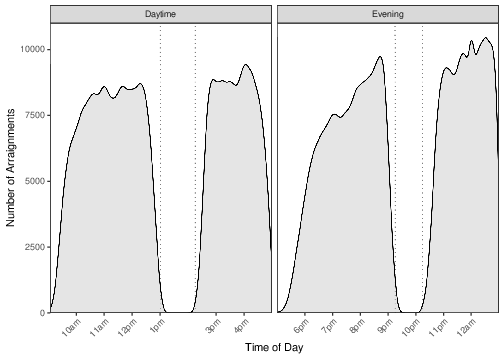
| Figure 1: Arraignment volume by time of day in consecutive decision-making sessions. Lunch (1–2:15pm) and dinner (9:15–10:15pm) are shown with dotted lines, and the curves are smoothed density estimates. The plot excludes the relatively small number of arraignments occurring during lunch, dinner, and after 1am. Arraignment volume is fairly stable throughout the day, although fewer arraignments occur at the start of the evening shift.
|
Our main outcome variable is whether a defendant was unconditionally released, which occurred in 58% of arraignments. Judges set some form of monetary bail in 40% of arraignments, and remanded defendants in about 1.5% of arraignments. The “supervised release” option was introduced in our jurisdiction in 2013, and judges chose this option in around 2% of arraignments between 2013–2015.
Our secondary outcome variable is whether the judge’s decision agreed with the prosecuting attorney’s request, i.e., if the prosecutor requested either
unconditional release, supervised release, some amount of money bail, or remand, and the judge decided on the same option. We note that according to this definition, we would say that agreement occurs even if the prosecutor requested a money bail amount that is very different than what the judge actually set, as long as the judge set a positive bail amount. This choice is supported by the fact that, as mentioned above, even small amounts of bail typically result in a defendant’s detention; however, we investigate alternative definitions of prosecutor-judge agreement in the Supplementary Information.
In our data, a prosecutor’s free-text bail request was only available from 2013–2015, so we restrict our analysis to those years for our analysis of agreement rates, and clean and standardize the request.7 After this process, and after removing the 12% of arraignments with missing prosecutor bail request information, we are left with a set of 39,157 cases for our investigation of judicial agreement with prosecutorial requests.
In addition to the (continuous) time of day, prosecutor bail request, and judge decision (including the numerical amount of bail set, if any), our data include an extensive set of covariates describing the defendant, charge, and courtroom characteristics of each arraignment. Defendant characteristics include age, sex, race, and criminal history — for example, the number of prior felony convictions, and the number of previous stints in prison.
Charge characteristics describe the classification (e.g., class A misdemeanor) and category of the top charge (e.g., trespassing).8
Courtroom characteristics include anonymized identifiers for the presiding judge and prosecuting attorney, as well as the type of defense counsel (e.g., the corresponding public defender agency, private representation, or court-appointed private representation, along with other less common options).
In particular, our data include many covariates that are plausibly related to a judge’s assessment of a defendant’s risk of missing a future court appearance, as well as other covariates like defendant race which may nevertheless influence judicial decisions. We provide more detailed information on covariates in the Supplementary Information.
Statistical approach
Our first statistical goal is to understand whether the time of day at which an arraignment occurs influences individual arraignment decisions, specifically, if the time of day influences a judge’s decision to unconditionally release a defendant, and if the time of day influences whether or not a judge’s decision agrees with the prosecutor’s request.
That is, we would like to know the extent to which judicial decisions would differ if arraignments were held at different times, holding constant relevant arraignment attributes.
If, hypothetically, all relevant arraignment characteristics — attributes of the defendant, case, and courtroom associated with a judge’s decision — were independent of arraignment time within each decision-making session (e.g., if arraignment order were randomly determined), one could examine aggregate release or agreement rates over the course of a session; observed variation in decision rates over time could then plausibly correspond to the effects of mental depletion or cognitive fatigue arising from repeated decision making.
As noted earlier, however, the distribution of certain arraignment characteristics may differ systematically for arraignments held at different times.9 To the extent that these arraignment characteristics influence judicial decisions, simply examining, e.g., observed release rates may provide a skewed estimate of how release decisions are actually influenced by arraignment time. Therefore, we would like to statistically adjust for relevant arraignment characteristics to estimate the release or agreement rates that would result if arraignments were, counterfactually, seen at different times of day. That is, we would like to estimate the effect of a continuous treatment variable (arraignment time) on a binary outcome (release decision or agreement with prosecutor recommendation) by adjusting for possible confounding variables.
One statistical strategy in this setting would be to model judicial decisions as a function of covariates and arraignment time using, e.g., logistic regression (Imbens, 2004). Assuming all time-varying arraignment characteristics that influence judge decisions have been measured, and that the model is correctly specified, a fitted coefficient on the arraignment time variable would correspond to an average effect of arraignment time on release decisions, or on agreement with the prosecutor. To mitigate possible model misspecification, we instead apply a recently developed nonparametric method for doubly robust estimation of continuous treatment effects, as introduced by (Kennedy et al., 2017). This two-step method involves first estimating both a treatment model (here, modeling the conditional distribution of arraignment time given arraignment characteristics), as well as an outcome model (e.g., a model for the average release rate given arraignment time and other characteristics), then regressing a combination of these estimates on treatment (arraignment time) using kernel smoothing.
This method is doubly robust in the sense that it will yield consistent estimates of the dose-response curve — the expected release rate or the expected agreement rate as a function of arraignment time, if all arraignments were (counterfactually) held at that time — if either the treatment model or the outcome model are correctly specified. Moreover, this method accommodates the use of flexible off-the-shelf machine learning methods in both steps, and is implemented in an R package. We note that causal conclusions drawn from this method (and alternative approaches, including matching and weighting estimators) assume that all confounding covariates are measured. We are fortunate to have a particularly rich set of measured covariates available in our data, bolstering the plausibility of this no-unmeasured-confounding assumption; we discuss this issue further in Section 3 and Section 4 below.
Our second statistical objective is to estimate the effects of a meal break on judicial arraignment decisions to assess the extent to which decisions are affected by the replenishment of mental or physical resources. As noted earlier, meals are taken at scheduled times, whereas the exact time any arraignment occurs depends on many exogenous factors. Moreover, judges do not typically see details of upcoming cases, so judges generally cannot, for example, deliberately postpone longer arraignments or those that present more challenging legal issues until after a meal. Therefore, we find it plausible that among arraignments shortly before and shortly after a meal break, whether a particular arraignment actually occurs before or after the break is effectively randomly determined. If this assumption of as-if random assignment holds, observed changes in release rates or agreement rates after a meal can be attributed to the effects of the break itself (Dunning, 2012). To investigate this assumption, we compare the distribution of covariates in 30-minute windows before and after lunch, and 30-minute windows before and after dinner in Supplementary Figure 1. In both cases (and for smaller and larger time windows (ImbensLemieux, 2008)), covariate distributions before and after a meal break are similar, supporting the plausibility of as-if random assignment. Consequently, we estimate the effects of a meal break by calculating the average difference in release rates and the average difference in agreement rates for arraignments in time windows shortly before and shortly after lunch, and shortly before and shortly after dinner.
3 Results
Effects of arraignment time on release decisions
We start by examining average unconditional release rates in the daytime and evening courtroom shifts without adjusting for covariates (Figure 2).
Figure 2 reveals three salient patterns:
(1) release rates drop almost 20 percentage points between 9–11am at the start of the daytime shift, and almost 10 percentage points between 5–6:30pm at the start of the evening shift;
(2) besides these beginning-of-shift declines, release rates appear fairly stable over time; and
(3) there is no apparent change in release rates after a meal break, when judges have eaten and, in theory, had a chance to rest.
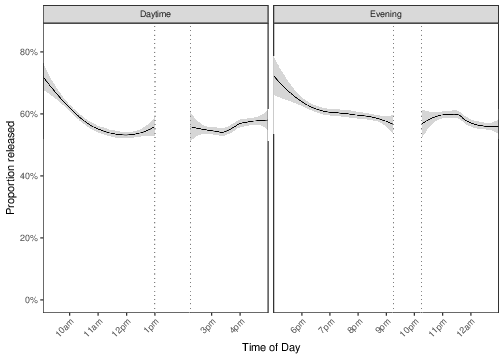
| Figure 2: The proportion of arraignments that result in unconditional release by time of day in consecutive shifts. Lunch (1–2:15pm) and dinner (9:15–10:15pm) are indicated by the dotted lines. The four curves are estimated using separate loess regressions, and the grey bands denote 95% CIs for the proportion released. The plot is based on 96,318 arraignments heard by 41 judges across two courtrooms; no adjustment is made for any covariates. At the beginning of the daytime shift and at the beginning of the evening shift there is an apparent decline in release rates. During the remainder of the shift, release rates are reasonably stable, and there is no clear change in release rates associated with a meal break. |
Although Figure 2 provides insight into aggregate patterns in release rates, we would like to understand whether the time of day at which an arraignment occurs influences individual arraignment decisions. Since arraignment time is not randomly determined, we examine the distribution of selected arraignment characteristics over the course of daytime and evening shifts in Figure 3. Although some arraignment characteristics appear stable throughout the day (e.g., the proportion of arraignments involving a defendant with more than one prior conviction or more than one prior failure to appear for court (denoted by “1+ FTA”)), others vary substantially. In particular, there are substantial differences in the proportion of arraignments held in each courtroom, the proportion of felony arraignments, and the proportion of arraignments where the defendant is represented by public counsel (i.e., one of several legal aid providers or a court-appointed attorney) at different times of day.
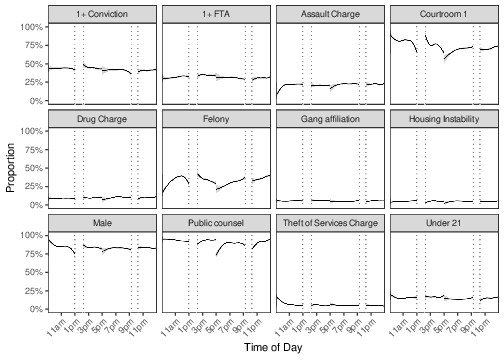
| Figure 3:
The distribution of selected defendant, charge, and court characteristics over the course of daytime and evening arraignment sessions. Although the prevalence of many characteristics remains fairly stable over the course of decision sessions, there are notable differences in, e.g., courtroom, sex, felony charge, and type of counsel at certain times of day.
|
To calculate covariate-adjusted release rates, we apply the doubly robust nonparametric estimator developed by (Kennedy et al., 2017) and implemented in the npcausal package. We adjust for the following covariates: defendant age, sex, race, housing status, prior convictions and missed court appearances, the classification and category of the top charge, the type of defense counsel, and indicators for the arraignment courtroom and presiding judge.10
We fit separate models in four decision-making sessions — before lunch (9am–1pm) and after lunch (2:15pm–5pm) in the daytime shift, and before dinner (5pm–9:15pm) and after dinner (10:15pm–1am) in the evening shift — to compare arraignments at similar times, when unobserved courtroom characteristics are less likely to vary.
Figure 4 shows the corresponding covariate-adjusted curve, i.e., for each arraignment time Figure 4 displays an estimate of the average release rate if all arraignments in the corresponding session were to have occurred, counterfactually, at that time. Note that Figure 4 should not be used to compare arraignments before lunch with those after lunch, or before dinner with those after dinner, as such arraignments occur within different decision-making sessions.
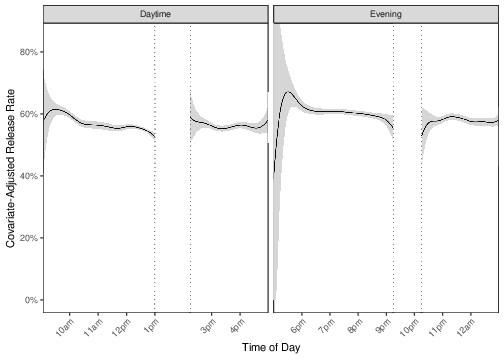
| Figure 4:
Covariate-adjusted release rates by time of day, estimated separately in each of four decision periods. Adjustment for defendant, charge, and arraignment characteristics is conducted using a doubly robust, nonparametric estimator; grey bands indicate 95% confidence intervals.
After accounting for differences in the distribution of arraignment characteristics at different times of day, release rates are slightly lower just before lunch compared to the beginning of the daytime shift, and just before dinner compared to the beginning of the evening shift. Arraignment time does not appear to influence judicial release decisions in the decision sessions after lunch and after dinner.
|
After adjusting for covariates, we find that release rates decline modestly in the before-lunch and before-dinner sessions, although we are unable to estimate these rates precisely at the beginning of any session because sample sizes are small.
Specifically, we estimate that if all before-lunch arraignments occurred at 10am, the release rate would be about 6 percentage points higher than if all before-lunch arraignments occurred at 1pm.
In the before-dinner session, if all arraignments occurred at 6pm, the release rate would be about 6 percentage points higher than if all such arraignments occurred at 9:15pm.
However, in both the after-lunch and after-dinner sessions, estimated release rates are stable over time, meaning that in each of these two decision sessions, release rates would be very similar if all arraignments occurred at different times within the same session.
We attribute the steep rise in covariate-adjusted release rates in the before-dinner session to a statistical artifact stemming from the small sample size at the beginning of the session (see also Figure 1).
Our findings suggest that differences in measured characteristics of arraignments that take place at different times account for much, but not all, of the variation observed in Figure 2 in the before-lunch and before-dinner sessions.
The fact that observed changes in decision rates only occur at certain times — and are quite small — stand in contrast to decision patterns observed in other contexts (Danziger et al., 2011a,Linder et al., 2014,Sievertsen et al., 2016,Hsiang et al., 2019).11
We repeat our analysis in the Supplementary Information, adjusting for several alternative, progressively larger sets of covariates, and find virtually identical patterns (Supplementary Figure 3). We also repeat our analysis separately for the nine judges with the highest caseloads and again find inconsistent evidence of decision fatigue. For most judges in most periods, estimated release rates are either almost constant over time, or time trends cannot be precisely estimated (Supplementary Figure 6). As another robustness check, we note that we obtain qualitatively similar results by simply fitting logistic regression models estimating release as a function of arraignment time and covariates (not shown).
Our findings imply that in our jurisdiction, arraignment time has a small effect on pretrial release decisions, and only at certain times of day.
We consider limitations of our results in the Discussion.
Next, however, we exploit the temporal discontinuity in decisions at lunch and dinner to estimate the effect of a meal break on a defendant’s chances of release before trial.
Effects of meal breaks on release decisions
To test whether pretrial decisions are affected by the replenishment of the mental resources of judges, as predicted by psychological depletion theories, we estimate changes in release rates before and after a meal break.
As noted earlier, among arraignments held shortly before or shortly after a meal, whether any given arraignment is actually held before or after a meal is plausibly independent of all arraignment characteristics, including arraignment characteristics that are not available in our data.
Therefore, a simple difference in average release rates after a meal versus before a meal should provide an unbiased estimate of the effect of a meal break on decisions.
We note, however, that while only 0.1% of arraignments in our data occur during the scheduled 1–2:15pm lunch break, around 1% of arraignments in our data occur during the 9:15–10:15pm dinner break. That is, whereas judges actually do appear to take a break during lunch, it seems as though judges occasionally work during dinner.
Consequently, estimates for the dinner break should be interpreted with more caution than estimates for the lunch break.
We find that differences in release rates after a meal break compared to before a meal break are small and statistically non-significant, in line with the observed patterns in Fig 2.
In particular, comparing release rates in the 30-minute window before lunch (12:30–1pm) to release rates in the 30-minute window after lunch (2:15–2:45pm), we find that rates increased by 0.5 percentage points (p = 0.74, 95% CI [-2pp, 3pp]).
For 15-minute windows before and after lunch, the change in release rates is -0.9 percentage points (p = 0.78, 95% CI [-7pp, 5pp]), and for 45-minute windows before and after lunch, the change in release rates is 1.4 percentage points (p = 0.18, 95% CI [-1pp, 4pp]).
Similarly, in 15-, 30-, and 45-minute windows before and after dinner, observed changes in release rates are again small and not significant, although this may be attributable to judges working through dinner and not having the chance to rest.12
Since we are interested in possible changes in release rates for individual judges, we also plot judge-level (unadjusted) effects of a meal break in Supplementary Figure 7, and find that most judges exhibit no statistically significant change in release rates after a meal. Overall, we find no evidence that a meal break affects pretrial release decisions, and therefore no evidence that the possible replenishment of mental resources of judges affects release decisions either.
Agreement between judges and prosecutors
To further explore the evidence for decision fatigue in judicial arraignment determinations, we examine the rate at which judges concur with prosecutor bail and release requests over the course of decision sessions and after meal breaks. Here, we follow other studies in examining the rate that decisions violate a “status quo” or “default” option, under the theory that such decisions are likely to be more mentally taxing than those that agree with a default option (Danziger et al., 2011a,Linder et al., 2014,Daljord et al., 2017).
In our setting, however, unconditional release is an implausible default option for some arraignments (e.g., those involving defendants with an extensive history of failing to appear in court); similarly, monetary bail may not be a plausible default option for other arraignments (e.g., those involving first-time defendants charged with a low-level offense). Given that research suggests judicial arraignment decisions are often influenced by prosecutor requests for bail (EbbesenKonecni, 1975,Dhami, 2003,Phillips, 2012,Dhamivan den Brink, 2022), we investigate the frequency with which judges agree with a prosecutor’s request for unconditional release, supervised release, money bail, or remand. We restrict our attention to the 39,157 arraignments in our data held between 2013–2015 where we have information on the nature and amount of prosecutorial bail requests.
In aggregate, we observe that when prosecutors request unconditional release (23% of arraignments), judges virtually always agree, unconditionally releasing the defendant 99% of the time. However, when prosecutors request a positive amount of money bail be set (76% of the time), judges set a positive amount of money bail 57% of the time (the specific amount that judges set is rarely what prosecutors ask for, however; see Supplementary Figure 2). Prosecutors almost never request that a defendant receive either supervised release (0.1% of arraignments) or remand (0.6% of arraignments), but when they do, judges agree with these requests 40% and 47% of the time, respectively.
Consequently, changes in agreement rates between judges and prosecutors are largely driven by changes in the rate at which judges actually set bail when prosecutors request some amount of money bail.13
In our setting, theories of mental depletion predict that when fatigued, judges should opt for the less taxing default option of agreeing with a prosecutor’s request. Therefore, we can examine the strength of evidence for depletion effects by looking at whether the rate at which judges agree with prosecutors increases as a decision session progresses, and whether it decreases after a meal break.
In Figure 5, panel (a), we plot the rate at which judicial decisions agree with prosecutor requests, and observe little variation in this rate over time or after a meal break. There is an apparent increase in the rate at which judges agree with prosecutors just before lunch, along with a corresponding decrease after lunch, but these changes are small and imprecisely estimated. In Figure 5, panel (b), we display covariate-adjusted agreement rates using the nonparametric doubly robust estimator introduced above to account for the possibility that base rates of agreement differ for different kinds of arraignments (we adjust for the same set of covariates as in Figure 4). We again find no evidence that agreement rates would be different if arraignments were held at different times during the same decision session, and our results are virtually identical if we adjust for additional covariates or use a more strict definition of “agreement” (Supplementary Figure 4 and Supplementary Figure 5).
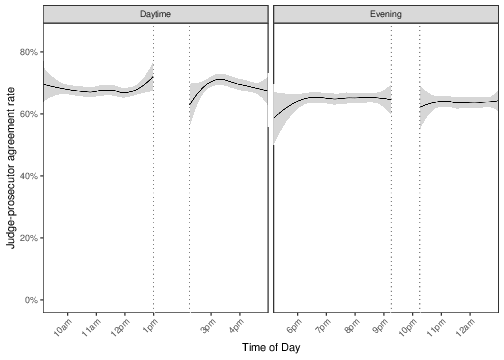 | 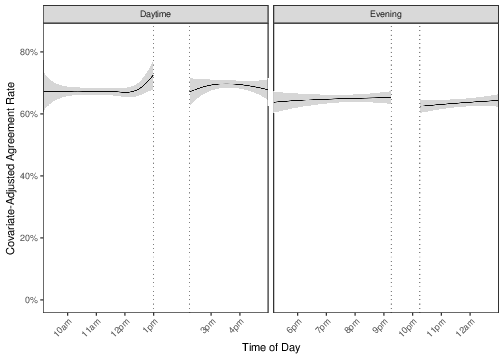 |
| (a) without covariate adjustment | (b) with covariate adjustment |
| Figure 5: The proportion of arraignments in which judicial decisions agree with prosecutor requests in consecutive shifts, without covariate adjustment (panel (a)) and with covariate adjustment (panel (b)).
Both plots are based on 39,157 arraignments that occurred between 2013–2015 where prosecutor request data are available.
The four curves in panel (a) are each estimated using loess regression, and the four curves in panel (b) are each estimated using a doubly robust, nonparametric estimator that adjusts for defendant, charge, and arraignment characteristics.
Dotted lines indicate lunch and dinner breaks and grey bands denote estimated 95% CIs for the proportion of judge decisions that agree with prosecutor recommendations.
There is minimal variation in agreement rates within each decision session whether or not covariate adjustment is performed. |
Next, we examine the effect of a lunch break on the rate at which judges agree with prosecutor bail requests. As with our analysis of release rates, we present unadjusted differences in agreement rates just after lunch compared to just before lunch. All estimates are statistically non-significant as suggested by Figure 5, panel (a). For 15-minute windows before and after lunch, the change in agreement rates is -7.1 percentage points (p = 0.16, 95% CI [-17pp, 3pp]), for 30-minute windows before and after lunch, the change in agreement rates is -2.7 percentage points (p = 0.21, 95% CI [7pp, 2pp]), and for 45-minute windows before and after lunch, the change in agreement rates is -0.02 percentage points (p = 0.99, 95% CI [-3pp, 3pp]).14
Our analysis of judge-prosecutor agreement rates over the course of decision sessions and around lunch reveals no evidence of decision fatigue, and implies that “status quo” theories of mental depletion are unlikely to apply to pretrial detention decisions.
We note, however, several limitations of using judge-prosecutor agreement as an outcome variable in our analyses. First, it is unclear exactly what it means for judges and prosecutors to agree on a bail amount, given that judges rarely set the exact bail requested by prosecutors, and frequently set bail substantially lower (Supplementary Figure 2). However, in Supplementary Figure 5 we observe almost identical results if we use a more stringent definition of “agreement” where we say that judges agree with prosecutor bail requests if the absolute difference between the amount requested by prosecutors and the amount actually set by judges is under $1000. Second, this outcome variable incorporates prosecutor behavior, which may itself be affected by decision fatigue or other unrecorded information in unknown ways. Finally, it is unclear in practice the extent to which agreeing with the prosecutor’s recommendation is a reasonable default option for judges. On one hand, as noted above, studies indicate that judicial bail decisions are generally influenced to some degree by prosecutor requests. On the other hand, judges in our court system frequently opt not to grant prosecutor requests, unconditionally releasing defendants in over 40% of cases where prosecutors request bail be set. Despite these limitations, we believe our analysis of agreement rates provides insight into the limited effects of decision fatigue in pretrial decision making in our jurisdiction.
4 Discussion
Psychological theories of depletion suggest that individuals’ mental resources are reduced by the act of making repeated, effortful decisions. These theories imply that the quality of repeated decisions should progressively decline as decision makers opt for easier, less mentally taxing options, and that interruptions to a sequence of decisions may replenish mental resources.
Our examination of nearly 100,000 pretrial arraignment decisions reveals that the time at which an arraignment occurs appears to have relatively little influence on a judge’s decision to release a defendant, and has almost no apparent influence on whether a judge’s decision broadly agrees with a prosecutor’s bail request.
Moreover, neither release rates nor judge-prosecutor agreement rates change significantly after a meal break, when judges may have the chance to replenish their physical and mental resources.
Our findings raise doubts about the relevance of proposed theories of mental depletion in repeated, high-stakes criminal justice decisions.
Repeating our release rate analysis separately for individual judges (Supplementary Figure 6 and Supplementary Figure 7) yields similar results.
Perhaps the most salient statistical limitation of our empirical analysis is that we are only able to adjust for arraignment characteristics that appear in our data.
If judicial decisions are informed by additional information that is unrecorded and that varies by time of day, unmeasured confounding might mask real arraignment time effects that might be attributable to the influence of mental depletion.
For instance, if arraignments held at 3pm are more likely to involve rude defendants than arraignments held at 5pm, and if rude defendants are less likely to appear at subsequent court appointments than polite defendants, similar release rates at 3pm and 5pm could reflect countervailing influences of mental fatigue (e.g., lowering release rates) and changes in the distribution of defendant attitudes (raising release rates).
While we cannot categorically rule out such unobserved confounding, we retain confidence in our findings for several reasons.
First, the set of measured covariates in our dataset is extensive, including attributes such as defendant educational and employment status, and prosecuting attorney ID; repeating our covariate adjustment strategy with additional covariates produces very similar results (Supplementary Figure 3).15
Second, since court personnel indicate that arraignment time is largely determined by arrest time, an unobserved confounder would need to be related to our outcome (release decisions or judge-prosecutor agreement) and to vary by the time of arrest.
Third, we believe it implausible that the influence of unmeasured confounders would almost exactly balance the influence of a possible depletion effect in the decision sessions where we observe no apparent change in release rates or judge-prosecutor agreement rates.
Additionally, we note that unobserved confounding is unlikely in our investigation of the effect of a meal break, where a temporal discontinuity arguably induces as-if random assignment of arraignments.
However, our results are limited to one court system in one country, even though our data include many decisions made by many judges in this jurisdiction.
If pretrial arraignment practices differ substantially in our jurisdiction compared to others, our results may have limited generalizability.
A second concern with our analysis is that we have no direct measure of how cognitively taxing pretrial release decisions are for arraignment court judges.
On one hand, a judge’s decision to release a defendant before trial involves discussion with other court personnel, has high stakes, and in theory, at least, involves integrating numerous pieces of information to determine a defendant’s risk of failing to appear for a subsequent court appearance; all these factors may impose mental demands on the judge.
On the other hand, evidence indicates that human judgments — including those of judges making bail decisions (DhamiAyton, 2001) — often conform to a “fast and frugal” approach to decision making, with limited information integration and reliance on one decision cue (Gigerenzer et al., 1999).
Arraignment hearings are often quite short, sometimes lasting just a few minutes (see, e.g., (Dhami, 2003), (Heaton et al., 2017), and (Stevenson, 2018)), suggesting that judges may indeed rely on simple heuristics, and although our data do not enable us to calculate the length of individual arraignments, the hearings in our jurisdiction that we personally observed were generally brief.
We note that in (Danziger et al., 2011a), the parole decisions studied also involved personnel (a criminologist and a social worker) besides the presiding judge and were similarly brief, lasting just six minutes on average.
A related concern is that, given the increasing use of automated decision aids to inform pretrial release decisions in the United States (Kleinberg et al., 2018,Jung et al., 2020,Goel et al., 2020), judges in our jurisdiction may not be susceptible to mental depletion processes if they rely heavily on such tools.
While automated decision aids were not in use in our jurisdiction in the time period we focus on, release recommendations based on structured checklists were available to judges.
However, the final decision is always made by the judge alone.
Our analysis — like many field studies of decision fatigue — is limited by the lack of a direct measure of the cognitive burden that judgments make on decision makers, and we hope that future studies are able to address this limitation.
Given that non-experimental studies in a variety of domains have found that decision quality degrades progressively and substantially within decision-making sessions (Danziger et al., 2011a,Linder et al., 2014,Dai et al., 2015,Sievertsen et al., 2016,AugenblickNicholson, 2016,Hsiang et al., 2019), and may be restored by a meal or other break, we interpret our findings in the context of this body of research.
First, our results imply that there may be a limited effect of decision fatigue in the pretrial context, but this effect appears to be small relative to other settings (e.g., (Danziger et al., 2011a)).
Next, the lack of observed arraignment time effects on release decisions in the post-lunch and post-dinner sessions, on judge-prosecutor agreement in all sessions, and, notably, the fact that release and agreement rates are unchanged after a lengthy lunch break are inconsistent with other field studies and at odds with predictions of psychological depletion theory.
Further research could examine the specific ways in which judges spend their time during meal breaks, to connect to a richer theory of decision fatigue that is able to accommodate our findings.
We note that even though we find only limited and inconsistent evidence of variation in release rates and judge-prosecutor agreement rates in the context of pretrial decision making, the volume of existing, careful field studies that find effects of decision fatigue lead us to believe that decision fatigue is a real phenomenon.
That is, it seems unlikely that all previous studies are, e.g., reporting statistical artifacts (i.e., analyzing data that by chance alone exhibit patterns consistent with large effects of decision fatigue), failing to appropriately adjust for relevant covariates ( (AugenblickNicholson, 2016), for example, leverages a natural experiment), or benefiting from publication bias that favors large, statistically significant effects.
In contrast, we find the evidence for prominent mental depletion theories less convincing.
We conclude by mentioning that although we estimated within-judge variation in release rates over time, we also find a substantial degree of variability in arraignment decisions between judges, in line with earlier investigations of inter-judge inconsistency (DhamiAyton, 2001,Dhami, 2005).
When examining a subset of cases with identical characteristics, we found that the mean release rate across judges had a standard deviation of almost 10 percentage points.16
In other words, while pretrial decisions appear to be at most mildly influenced by decision fatigue, it appears that justice — at arraignment, at least — is influenced to a large degree by the identity of the presiding judge.
To the extent that such variability is at odds with stated principles of justice, future work can examine how to address between-judge inconsistency through, for example, additional training, or through policies, laws, and guidelines that appropriately constrain judicial discretion.
Looking forward, we hope this paper informs debates over decision fatigue and depletion theories, and adds to an understanding of how high-stakes decisions are made.
References
-
[AugenblickNicholson, 2016]
-
Augenblick, N. & Nicholson, S. (2016).
Ballot position, choice fatigue, and voter behaviour.
The Review of Economic Studies, 83(2), 460–480.
- [Baumeister et al., 1998]
-
Baumeister, R. F., Bratslavsky, E., Muraven, M., & Tice, D. M. (1998).
Ego depletion: is the active self a limited resource?
Journal of personality and social psychology, 74 5,
1252–65.
- [BaumeisterVohs, 2016]
-
Baumeister, R. F. & Vohs, K. D. (2016).
Misguided effort with elusive implications.
Perspectives on Psychological Science, 11(4), 574–575.
- [BoksemTops, 2008]
-
Boksem, M. A. & Tops, M. (2008).
Mental fatigue: costs and benefits.
Brain research reviews, 59(1), 125–139.
- [Carter et al., 2015]
-
Carter, E. C., Kofler, L. M., Forster, D. E., & McCullough, M. E. (2015).
A series of meta-analytic tests of the depletion effect: Self-control
does not seem to rely on a limited resource.
Journal of Experimental Psychology: General, 144(4), 796.
- [CarterMcCullough, 2014]
-
Carter, E. C. & McCullough, M. E. (2014).
Publication bias and the limited strength model of self-control: has
the evidence for ego depletion been overestimated?
Frontiers in psychology, 5, 823.
- [Chen et al., 2016]
-
Chen, D. L., Moskowitz, T. J., & Shue, K. (2016).
Decision making under the gambler’s fallacy: Evidence from asylum
judges, loan officers, and baseball umpires.
The Quarterly Journal of Economics, 131(3), 1181–1242.
- [Dai et al., 2015]
-
Dai, H., Milkman, K. L., Hofmann, D. A., & Staats, B. R. (2015).
The impact of time at work and time off from work on rule compliance:
the case of hand hygiene in health care.
Journal of Applied Psychology, 100(3), 846.
- [Daljord et al., 2017]
-
Daljord, Ø., Urminsky, O., & Ureta, J.-M. (2017).
The status quo theory of depletion does not explain the Israeli
parole decisions.
Available at SSRN 3448164.
-
Dang, J. (2016).
Commentary: A multilab preregistered replication of the ego-depletion
effect.
Frontiers in Psychology, 7, 1155.
-
Danziger, S., Levav, J., & Avnaim-Pesso, L. (2011a).
Extraneous factors in judicial decisions.
Proceedings of the National Academy of Sciences, 108(17),
6889–6892.
- [Danziger et al., 2011b]
-
Danziger, S., Levav, J., & Avnaim-Pesso, L. (2011b).
Reply to Weinshall-Margel and Shapard: Extraneous factors in judicial
decisions persist.
Proceedings of the National Academy of Sciences, 108(42),
E834–E834.
- [Dhami, 2003]
-
Dhami, M. K. (2003).
Psychological models of professional decision making.
Psychological Science, 14(2), 175–180.
- [Dhami, 2005]
-
Dhami, M. K. (2005).
From discretion to disagreement: explaining disparities in judges’
pretrial decisions.
Behavioral Sciences & the Law, 23(3), 367–386,
https://doi.org/https://doi.org/10.1002/bsl.619
https://onlinelibrary.wiley.com/doi/abs/10.1002/bsl.619.
- [DhamiAyton, 2001]
-
Dhami, M. K. & Ayton, P. (2001).
Bailing and jailing the fast and frugal way.
Journal of behavioral decision making, 14(2), 141–168.
- [Dhamivan den Brink, 2022]
-
Dhami, M. K. & van den Brink, Y. N. (2022).
A multi-disciplinary and comparative approach to evaluating pre-trial
detention decisions: towards evidence-based reform.
European Journal on Criminal Policy and Research, (pp. 1–15).
- [Dobbie et al., 2018]
-
Dobbie, W., Goldin, J., & Yang, C. S. (2018).
The Effects of Pretrial Detention on Conviction, Future Crime, and
Employment: Evidence from Randomly Assigned Judges.
American Economic Review, 108(2), 201–40,
https://doi.org/10.1257/aer.20161503
http://www.aeaweb.org/articles?id=10.1257/aer.20161503.
- [Dunning, 2012]
-
Dunning, T. (2012).
Natural experiments in the social sciences: a design-based
approach.
Cambridge University Press.
- [EbbesenKonecni, 1975]
-
Ebbesen, E. B. & Konecni, V. J. (1975).
Decision making and information integration in the courts: The
setting of bail.
Journal of Personality and Social Psychology, 32(5), 805.
- [ErenMocan, 2018]
-
Eren, O. & Mocan, N. (2018).
Emotional judges and unlucky juveniles.
American Economic Journal: Applied Economics, 10(3),
171–205.
- [Friese et al., 2019]
-
Friese, M., Loschelder, D. D., Gieseler, K., Frankenbach, J., & Inzlicht, M.
(2019).
Is ego depletion real? An analysis of arguments.
Personality and Social Psychology Review, 23(2),
107–131.
- [Gigerenzer et al., 1999]
-
Gigerenzer, G., Todd, P. M., & the ABC Research Group (1999).
Simple heuristics that make us smart.
New York: Oxford University Press, USA.
- [Glöckner, 2016]
-
Glöckner, A. (2016).
The irrational hungry judge effect revisited: Simulations reveal that
the magnitude of the effect is overestimated.
Judgment and Decision making, 11(6), 601.
- [Goel et al., 2020]
-
Goel, S., Shroff, R., Skeem, J. L., & Slobogin, C. (2020).
The accuracy, equity, and jurisprudence of criminal risk assessment.
Research Handbook on Big Data Law.
- [Gupta et al., 2016]
-
Gupta, A., Hansman, C., & Frenchman, E. (2016).
The heavy costs of high bail: Evidence from judge randomization.
The Journal of Legal Studies, 45(2), 471–505.
- [Hagger et al., 2016]
-
Hagger, M. S., et al. (2016).
A multilab preregistered replication of the ego-depletion effect.
Perspectives on Psychological Science, 11(4), 546–573.
- [Hagger et al., 2010]
-
Hagger, M. S., Wood, C., Stiff, C., & Chatzisarantis, N. L. (2010).
Ego depletion and the strength model of self-control: a
meta-analysis.
Psychological bulletin, 136(4), 495.
- [Heaton et al., 2017]
-
Heaton, P., Mayson, S., & Stevenson, M. (2017).
The downstream consequences of misdemeanor pretrial detention.
Stan. L. Rev., 69, 711.
- [Hsiang et al., 2019]
-
Hsiang, E. Y., Mehta, S. J., Small, D. S., Rareshide, C. A., Snider, C. K.,
Day, S. C., & Patel, M. S. (2019).
Association of primary care clinic appointment time with clinician
ordering and patient completion of breast and colorectal cancer screening.
JAMA network open, 2(5), e193403–e193403.
- [Imbens, 2004]
-
Imbens, G. W. (2004).
Nonparametric estimation of average treatment effects under
exogeneity: A review.
Review of Economics and statistics, 86(1), 4–29.
- [ImbensLemieux, 2008]
-
Imbens, G. W. & Lemieux, T. (2008).
Regression discontinuity designs: A guide to practice.
Journal of econometrics, 142(2), 615–635.
- [Jung et al., 2020]
-
Jung, J., Concannon, C., Shroff, R., Goel, S., & Goldstein, D. G. (2020).
Simple rules to guide expert classifications.
Journal of the Royal Statistical Society: Series A (Statistics
in Society).
- [Kahneman, 2011]
-
Kahneman, D. (2011).
Thinking, fast and slow.
Macmillan.
- [Kennedy et al., 2017]
-
Kennedy, E. H., Ma, Z., McHugh, M. D., & Small, D. S. (2017).
Non-parametric methods for doubly robust estimation of continuous
treatment effects.
Journal of the Royal Statistical Society: Series B (Statistical
Methodology), 79(4), 1229–1245.
- [Kleinberg et al., 2018]
-
Kleinberg, J., Lakkaraju, H., Leskovec, J., Ludwig, J., & Mullainathan, S.
(2018).
Human decisions and machine predictions.
The quarterly journal of economics, 133(1), 237–293.
- [LesliePope, 2017]
-
Leslie, E. & Pope, N. G. (2017).
The unintended impact of pretrial detention on case outcomes:
Evidence from New York City arraignments.
The Journal of Law and Economics, 60(3), 529–557.
- [Linder et al., 2014]
-
Linder, J. A., Doctor, J. N., Friedberg, M. W., Nieva, H. R., Birks, C.,
Meeker, D., & Fox, C. R. (2014).
Time of day and the decision to prescribe antibiotics.
JAMA Internal Medicine, 174(12), 2029–2031.
- [Phillips, 2012]
-
Phillips, M. T. (2012).
A decade of bail research in New York City.
CJA, New York City Criminal Justice Agency, Incorporated.
- [Pignatiello et al., 2020]
-
Pignatiello, G. A., Martin, R. J., & Hickman Jr, R. L. (2020).
Decision fatigue: A conceptual analysis.
Journal of health psychology, 25(1), 123–135.
- [RachlinskiWistrich, 2017]
-
Rachlinski, J. J. & Wistrich, A. J. (2017).
Judging the judiciary by the numbers: Empirical research on judges.
Annual Review of Law and Social Science, 13, 203–229.
- [Sievertsen et al., 2016]
-
Sievertsen, H. H., Gino, F., & Piovesan, M. (2016).
Cognitive fatigue influences students’ performance on standardized
tests.
Proceedings of the National Academy of Sciences, 113(10),
2621–2624.
- [Stevenson, 2018]
-
Stevenson, M. T. (2018).
Distortion of Justice: How the Inability to Pay Bail Affects Case
Outcomes.
The Journal of Law, Economics, and Organization, 34(4),
511–542,
https://doi.org/10.1093/jleo/ewy019
https://doi.org/10.1093/jleo/ewy019.
- [Suffet, 1966]
-
Suffet, F. (1966).
Bail Setting: A Study of Courtroom Interaction.
Crime & Delinquency, 12(4), 318–331,
https://doi.org/10.1177/001112876601200403
https://doi.org/10.1177/001112876601200403.
- [TorresWilliams, 2022]
-
Torres, L. C. & Williams, J. H. (2022).
Tired Judges? An Examination of the Effect of Decision Fatigue in
Bail Proceedings.
Criminal Justice and Behavior, 49(8), 1233–1251,
https://doi.org/10.1177/00938548221081072
https://doi.org/10.1177/00938548221081072.
- [TylerBurns, 2008]
-
Tyler, J. M. & Burns, K. C. (2008).
After depletion: The replenishment of the self’s regulatory
resources.
Self and Identity, 7(3), 305–321.
- [TylerHuo, 2002]
-
Tyler, T. R. & Huo, Y. J. (2002).
Trust in the law: Encouraging public cooperation with the police
and courts.
Russell Sage Foundation.
- [Vadillo et al., 2016]
-
Vadillo, M. A., Gold, N., & Osman, M. (2016).
The bitter truth about sugar and willpower: The limited evidential
value of the glucose model of ego depletion.
Psychological Science, 27(9), 1207–1214.
- [Vadillo et al., 2018]
-
Vadillo, M. A., Gold, N., & Osman, M. (2018).
Searching for the bottom of the ego well: Failure to uncover ego
depletion in Many Labs 3.
Royal Society Open Science, 5(8), 180390.
- [Vohs et al., 2008]
-
Vohs, K., Baumeister, R., Schmeichel, B. J., Twenge, J., Nelson, N. M., &
Tice, D. (2008).
Making choices impairs subsequent self-control: a limited-resource
account of decision making, self-regulation, and active initiative.
Journal of personality and social psychology, 94 5,
883–98.
- [Weinshall-MargelShapard, 2011]
-
Weinshall-Margel, K. & Shapard, J. (2011).
Overlooked factors in the analysis of parole decisions.
Proceedings of the National Academy of Sciences, 108(42),
E833–E833.
Supplementary Information
Additional information on covariates
Here, we provide more detailed information about the covariates available in our data.
Defendant characteristics in our data include age; sex; race (categorized as “Black”, “White”, “Hispanic”, and “Other”); and an indicator for whether the defendant has unstable housing. Defendant characteristics also include extensive information on prior criminal record, including prior felony convictions; prior misdemeanor convictions; prior failures to appear for scheduled court appearances; prior convictions for violent offenses; prior convictions for drug offenses; prior domestic violence arrests within the previous 36 months; previous stints in prison; previous stints in jail; and indicators for whether the defendant is under 21 and charged with a violent crime, is a known gang member, or has had a previous order of protection. From 2013–2015, our data include information on a defendant’s educational status (e.g., “some high school” or “college”); whether the defendant has a housemate; number of dependents; whether the defendant lives in the metropolitan area containing the jurisdiction; current employment status (e.g., “odd jobs” or “self-employed, part-time”); and whether the defendant is currently in school (full time or part time).
Charge-related covariates include information on the general classification (one of nine types) and category (one of 29 designations). The 9 top charge classifications are, in decreasing order of severity, Class A felony; Class B felony; Class C felony; Class D felony; Class E felony; Class A misdemeanor; Class B misdemeanor; Class U misdemeanor; and Violation/Infraction.
The 29 top charge categories are, in alphabetical order: Administrative code violation; Assault; Burglary; Conspiracy; Contempt; Disorderly conduct; Drugs; Forged instrument; Forgery; Gambling; Grand larceny; Homicide; ID theft; Marijuana; Mischief; Other felony; Other misdemeanor; Prostitution; Resisting arrest/obstructing government administration; Robbery; Sex offense; Stolen property; Theft; Theft of services; Transit; Trespass; Unlicensed general vending; Vehicle/traffic; and Weapons.
Arraignment characteristics include indicators for the presiding judge, prosecuting attorney, and courtroom; indicators for the arraignment year, month, and weekday; and how the case was processed before arraignment (e.g., via phone call between arresting officer and district attorney’s office). Arraignment characteristics also include the type of defense counsel. In our jurisdiction, a defendant’s defense attorney is most commonly either employed by one of three nonprofit legal aid providers; is a private attorney engaged by the jurisdiction to provide free counsel; or is a private attorney directly engaged by the defendant. In Supplementary Figure 1, these categories are indicated by “Public Counsel 1,” “Public Counsel 2,” “Public Counsel 3,” “Private/Public,” and “Private,” respectively. Occasionally, defendants choose to represent themselves or receive representation through a partnership with the law school of a local university; these categories are not shown in Supplementary Figure 1, but are included in our statistical models, along with indicators for “missing” or “unknown” counsel.
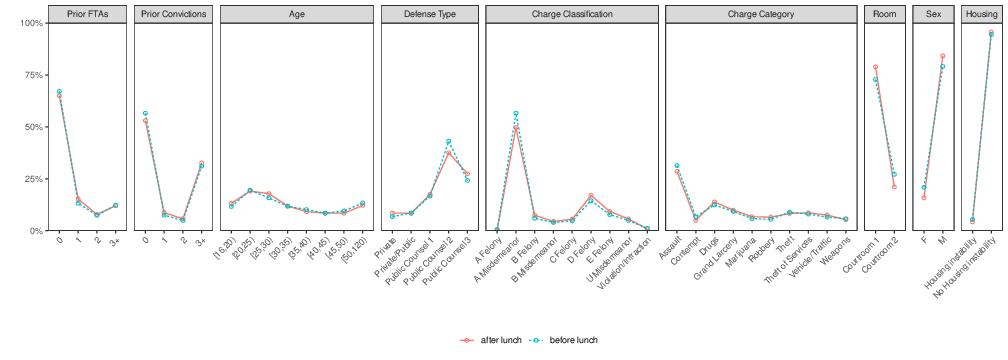
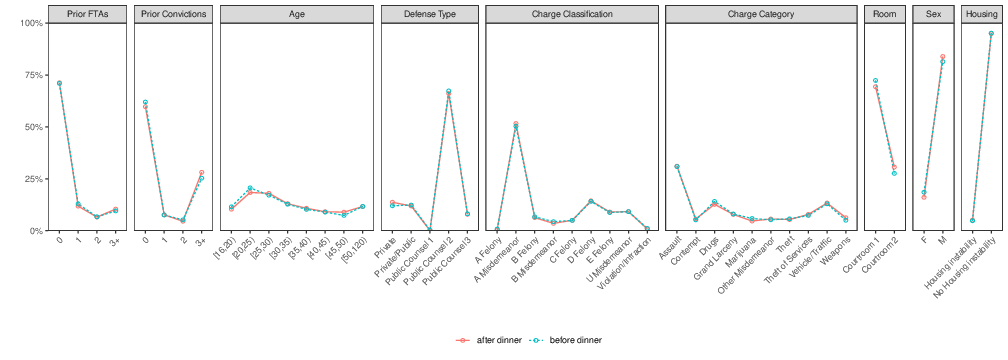
| Supplementary Figure 1:
The distribution of the number of previous failures to appear; number of previous convictions; defendant age; defense attorney type; top charge classification; top charge category (among the 10 most frequently occurring categories); courtroom; defendant sex; and housing stability for arraignments in our dataset before and after lunch (top) and before and after dinner (bottom).
In the top plot, the blue curves show distributions of covariates in the 30-minute window before lunch (12:30–1pm), and the red curves show distributions of covariates in the 30-minute window after lunch (2:15–2:45pm).
In the bottom plot, the blue curves show distributions of covariates in the 30-minute window before dinner (8:45–9:15pm), and the red curves show distributions of covariates in the 30-minute window after dinner (10:15–10:45pm).
In both plots, differences between the distributions are fairly small, consistent with as-if random assignment of arraignments between these two periods. |
Additional information on bail requests
Supplementary Figure 2 shows a boxplot of the difference between the amount of bail requested by prosecutors and the amount of bail set by judges for the 29,506 arraignments where prosecutors requested some amount of money bail.17 For clarity, we remove approximately 10% of arraignments where the difference between requested and actual bail is less than -$10,000 or greater than $20,000. Judges rarely set the exact amount of money bail that prosecutors request (this happens in about 8% of these arraignments), and mostly set bail lower than requested.
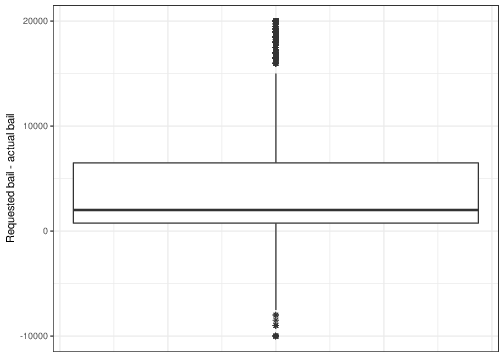
| Supplementary Figure 2: Boxplot of the difference between bail amounts requested by prosecutors and actual bail amounts set by judges, for the approximately 30,000 arraignments between 2013–2015 where prosecutors requested money bail be set; extreme observations have been excluded for clarity. Judges rarely set exactly the same bail amount requested by a prosecutor, and in particular, judges set lower bail amounts than prosecutors request over 75% of the time. |
Supplementary models
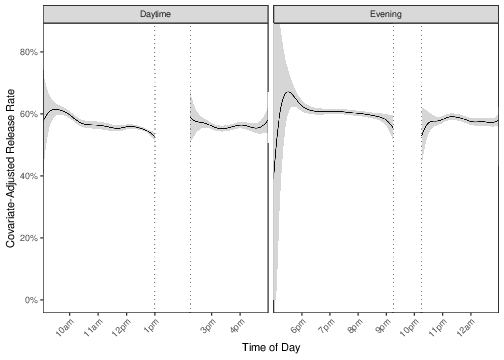 | 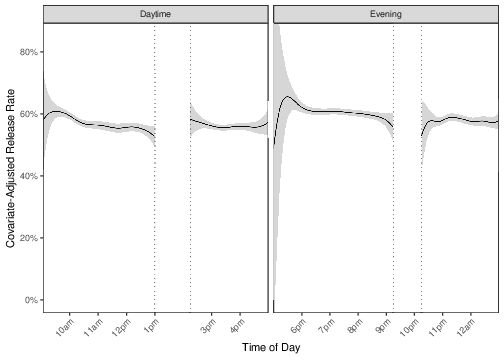 |
| (a) Model 1 covariates (same as Figure 4) | (b) Model 2 covariates |
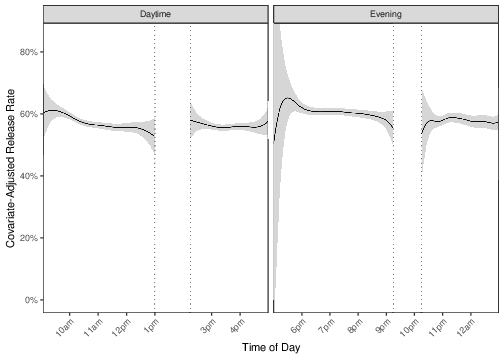 | 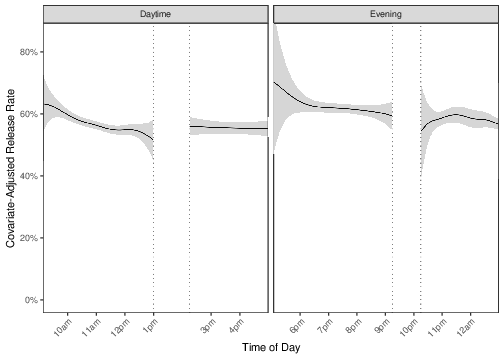 |
| (c) Model 3 covariates | (d) Model 4 covariates |
| Supplementary Figure 3: Estimated release rates adjusting for four sets of observed arraignment characteristics, with 95% confidence intervals. Panel (a) reproduces Figure 4 in the main text; panels (b)-(d) add progressively more covariates, and panel (d) is estimated using data from 2013–2015. Adjusted release rates are virtually identical across all four models, providing additional evidence that arraignment time has relatively little influence on release decisions once relevant differences in arraignment characteristics are accounted for. |
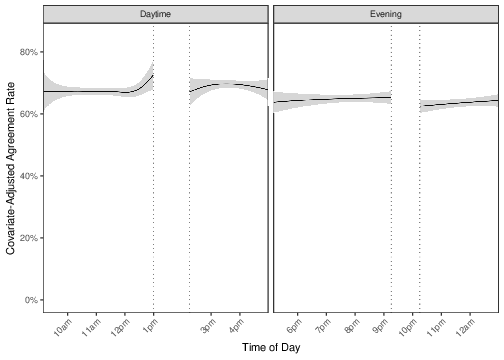 | 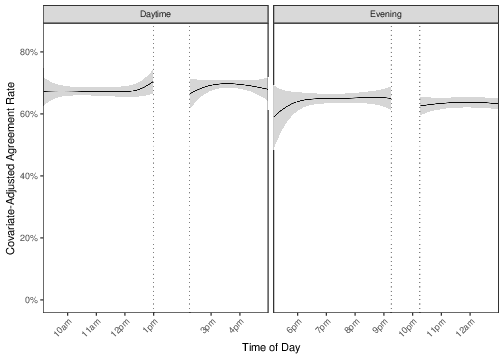 |
| (a) Model 1 covariates (same as Figure 5 (b)) | (b) Model 2 covariates |
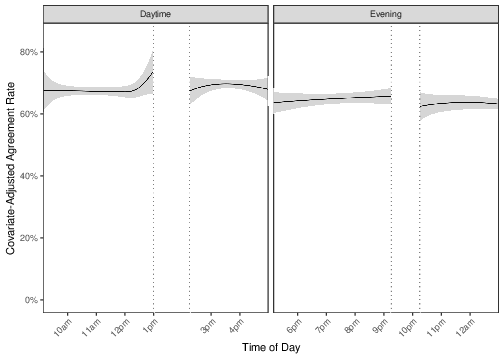 | 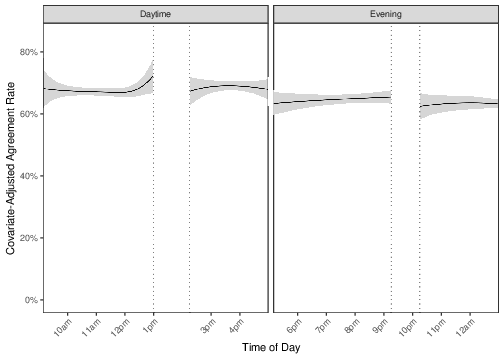 |
| (c) Model 3 covariates | (d) Model 4 covariates |
| Supplementary Figure 4: Estimated rates of agreement between judges and prosecutors adjusting for four sets of observed arraignment characteristics, with 95% confidence intervals. Panel (a) reproduces Figure 5 (b) in the main text; panels (b)-(d) add progressively more covariates. All models are estimated using data from 2013–2015, when prosecutorial bail request data became available. Adjusted agreement rates are very similar across all models and support the finding that arraignment time has minimal influence on the rate at which judicial decisions agree with prosecutorial bail requests. |
To assess the robustness of our main findings in Section 3, we first repeat our covariate adjustment strategy with three alternate sets of observed arraignment characteristics:
Model 1 (reported in main text):
defendant age, sex, and race; prior felony convictions; prior misdemeanor convictions; prior failures to appear for scheduled court appearances; an indicator for whether the defendant has unstable housing; the classification and category of the top charge; the type of defense counsel; an indicator for which of the two courtrooms the arraignment took place in; and an indicator variable for the presiding judge.
Model 2 covariates:
Model 1 covariates and prior convictions for violent offenses; prior convictions for drug offenses; prior domestic violence arrests within the previous 36 months; previous stints in prison; previous stints in jail; indicators for whether the defendant is under 21 and charged with a violent crime, is a known gang member, or has had a previous order of protection; how the case was processed before arraignment (e.g., via phone call between arresting officer and district attorney’s office); and indicators for the arraignment year, month, and weekday.
Model 3 covariates:
Model 2 covariates and an indicator for the prosecuting attorney.
Model 4 covariates:
Model 3 covariates as well as the defendant’s educational status (e.g., “some high school” or “college”); whether the defendant has a housemate; number of dependents; whether the defendant lives in the metropolitan area containing the jurisdiction; current employment status (e.g., “odd jobs” or “self-employed, part-time”); and whether the defendant is currently in school (full time or part time). Since the additional covariates in Model 4 are only available from 2013 onwards, we estimate Model 4 on the subset of arraignments between 2013–2015.
The results, shown in Supplementary Figure 3 and Supplementary Figure 4 indicate that covariate-adjusted release rates and covariate-adjusted agreement rates are virtually identical across all four models, even when adjusting for considerably more variables. Presumably, this is because additional covariates in Models 2–4 have stable distributions over the course of the day, are unrelated to judge release decisions or agreement rates, or are highly correlated with covariates in Model 1. These figures suggest that our main results in Figure 4 and Figure 5 are robust to adjustment for additional observed arraignment characteristics, and may also be robust to differences in the distribution of unmeasured arraignment characteristics by arraignment time.
In our analysis of judge-prosecutor agreement rates, we defined “agreement” to mean (in part) that judges set any positive amount of money bail if money bail was requested by the prosecutor, even if the amount set differs significantly from the amount requested. In Supplementary Figure 5, we again display covariate-adjusted judge-prosecutor agreement rates (adjusting for Model 1 covariates) for the 39,157 arraignments between 2013–2015 where we have prosecutor request information, but with a more stringent definition of agreement. Specifically, we say that judges agree with prosecutor requests if the prosecutor requests unconditional release and the judge grants it; if the prosecutor requests supervised release and the judge grants it; if the prosecutor requests remand and the judge grants it; or if the prosecutor requests money bail and the judge sets money bail at a positive amount that differs from the requested amount by $1000 or less.
Supplementary Figure 5 shows that with this alternative definition of concurrence between judge decisions and prosecutor requests, covariate-adjusted agreement rates are still stable over the course of each decision session. Comparing agreement rates before and after lunch with this alternative definition of agreement, we again find that differences are relatively small and not statistically significant. We also find similar results if we use a threshold of $500 to characterize a judge “agreeing” with a prosecutor’s money bail request.
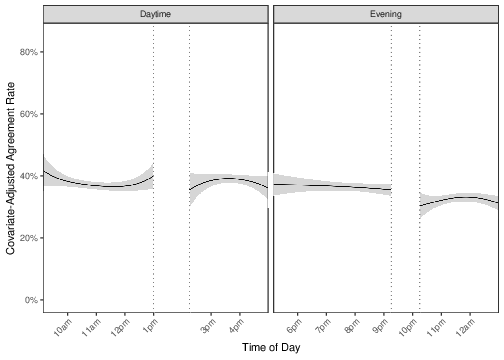
| Supplementary Figure 5: The proportion of arraignments in which judicial bail amounts set agree with prosecutor bail requests to within $1000, adjusting for defendant, charge, and arraignment characteristics separately in four consecutive decision sessions.
This plot is based on the 39,157 arraignments that occurred between 2013–2015 where prosecutor request data are available; dotted lines indicate lunch and dinner breaks and grey bands denote estimated 95% CIs for the proportion of judge decisions that agree with prosecutor recommendations.
With this alternative definition of “agreement,” we again observe minimal variation within each decision session. |
In Supplementary Figure 6 we repeat the release rate analysis in the main text (i.e., adjusting for Model 1 covariates) separately for the nine judges in our dataset with the highest caseloads. Although overall release rates vary across judges, temporal patterns are fairly similar and, to the extent they can be estimated precisely, are mostly consistent with minimal changes in release rates over time.
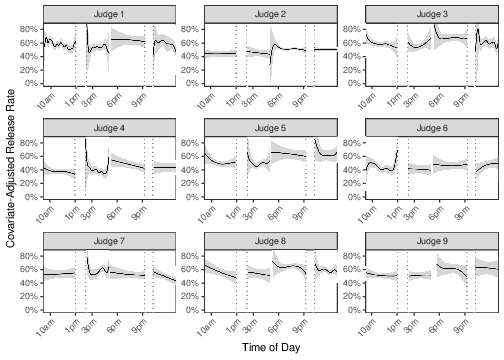
| Supplementary Figure 6: Estimated release rates by arraignment time for each of the nine judges in our dataset who preside over the most arraignments. We adjust for Model 1 covariates (as described above) using the same doubly robust approach as in the main text, with 95% confidence intervals indicated in grey.
For most judges and most time periods, release rates are either fairly stable or cannot be estimated precisely, suggesting that arraignment time has a limited influence on the release decisions of individual judges. |
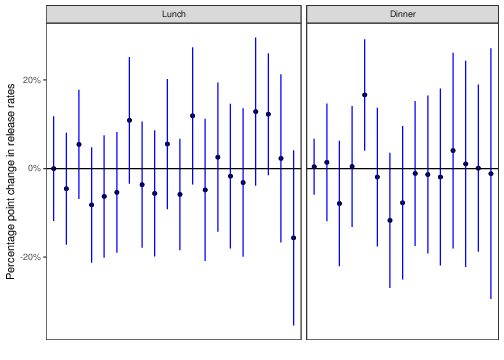
| Supplementary Figure 7: The percentage point change in release rates after a meal for individual judges. Each point and line in the left panel represents the observed difference in release rates (in percentage points) and 95% confidence interval for each judge who saw at least 100 cases across the 30-minute windows before and after lunch. Each point and line in the right panel corresponds to the same quantity for each judge who saw at least 100 cases across the 30-minute windows before and after dinner. For almost all judges, there is no statistically significant difference in release rates due to a meal.
|
This document was translated from LATEX by
HEVEA.



















